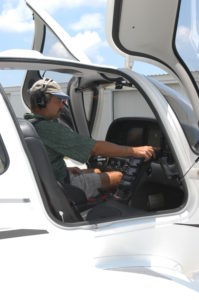Small Plane, Part II
By Terence WittI had just arrived in Florida’s panhandle, after flying through moderately poor conditions. My friend was off to check on her sick mom and I needed to get back home before the weather got worse.
The interminable rain was pounding the airport, and I waited for about 10 minutes for it to relent, but it just kept coming. Not wanting to give the storm any more time to build, I filed my flight plan and took off in driving rain and IFR conditions (600 ceiling). Turbulence was mild, and the weather looked about the same as when I flew through it an hour ago. There was a solid wall of moderate to heavy rain stretching for hundreds of miles from Atlanta to far into the Gulf of Mexico. As I started out into the Gulf, to cut across Florida’s ‘armpit’ on my East-bound flight, I reported to Jacksonville Center that my flight conditions were mild to moderate turbulence and rain.
I was about 10 miles offshore when Mother Nature reminded me, in no uncertain terms, who’s boss. Two walls of thunderstorms converged, and rain and turbulence jumped from moderate to extreme. I slowed the plane to what’s called ‘maneuvering speed’. At this speed, so the saying goes, you can apply immediate and full control input without damaging the plane. Since the turbulence was extreme, this is exactly what I was doing to keep the plane level. I reported to Center to please forget about the ‘moderate’ conditions that I had reported earlier. The turbulence was so violent that if my flight instruments were the old style ‘steam gauges’, I wouldn’t be able to see them. My SR22 has a large LCD panel that gives you the plane’s attitude (wings level, ascending or descending) even when your head is being slammed against the ceiling or your door window.
Now when I say ‘extreme turbulence’, please keep in mind that I ride motocross bikes on a track that can get very hacked up. As the flight conditions continued to deteriorate, motocross started to seem very mild indeed. I think a professional bull rider might have even found it disconcerting. The rain was so intense that the sound of it hammering the windshield (even at my reduced speed) made it difficult to hear Jacksonville Center (with the radio cranked up). Then the rain got worse, to the point where droplets were hitting my face inside the cockpit – it was actually coming in through the air vents (which collect their air several feet out on the wings). That’s when the lightning started. Lots and lots of lightning. Beautiful to watch from the safety of distance; disconcerting when flashes are all around you, to include above and below. The lightning did relieve the eerie darkness in the cockpit, but I would have preferred a less dramatic light source.
By then I was about 20 miles offshore over the Gulf, and was becoming a little concerned. The way it works is this. Rain makes you wet, lightning is generally not a problem, but turbulence can kill you. So although intense rain tends to be associated with intense turbulence, it’s not always a one-to-one correlation, and rain is just an indicator, even when a little bit of it is making it into your cockpit. Turbulence – now that’s a problem, and it’s all about the trend. Turbulence starts small, builds to some maximum level, reaches a plateau, then eventually decreases. The trick is to make sure that the turbulence doesn’t get to the point where your wings come off. Unfortunately, as you caper about, like a suitcase in a wind tunnel, you know the turbulence is increasing; you just don’t know when it is going to plateau. Please, please, let me off this unmerry-go-round.
Since this storm was big, I had plenty of time to run through a couple of sobering scenarios. I know a couple of pilots who claim to have bent their wings in extreme turbulence. Since my plane is composite construction, my wings don’t really bend. Their failure modes are separation or breaking. However, even then I have an option few other planes have – a parachute integrated into my plane’s airframe. So if turbulence exceeds the structural capability of my plane, the best-case scenario plays out like this. Deploy the chute, 20 miles offshore in the Gulf of Mexico, in a raging thunderstorm. Suffice as to say that I won’t make it home in time for dinner, even if the Coast Guard finds my emergency locator beacon.
And then the turbulence and rain began to abate, and were soon all the way down to merely ‘alarming’. The trend continued, and I was left with a smooth ride over Orlando. There was a light misty rain south of Orlando, and Orlando Approach asked me if I wanted to deviate to avoid it. “No”, I said and laughed (I don’t think hysterically), “I will persevere”. As I flew home I thought a little about how Mother Nature had really clarified things for me. You know when you’re in a car, sometimes there’s a gnat buzzing against the windshield, trying to get out? And there you are, slapping your hand against the inside of the windshield trying to crush it? You’re playing the role of Mother Nature, and I was the gnat. I got away this time.
I landed at my home airport, taxied to my hanger. As I was putting my plane away, I hugged it and kissed it on the propeller. We bonded.

